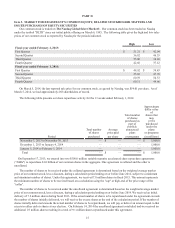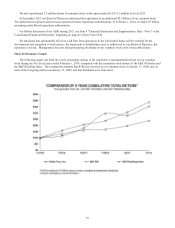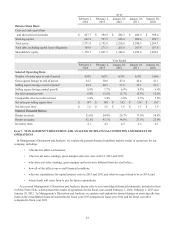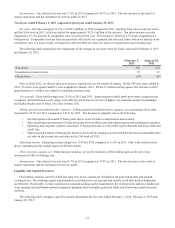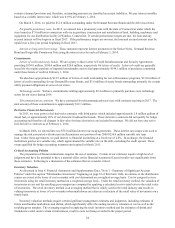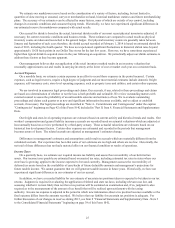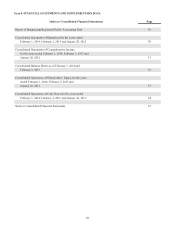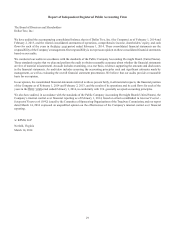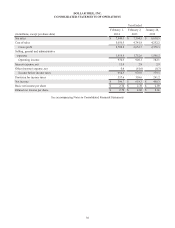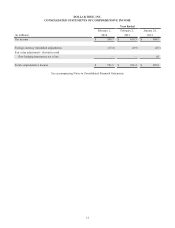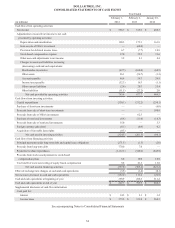Dollar Tree 2013 Annual Report Download - page 40
Download and view the complete annual report
Please find page 40 of the 2013 Dollar Tree annual report below. You can navigate through the pages in the report by either clicking on the pages listed below, or by using the keyword search tool below to find specific information within the annual report.24
contain a demand provision and, therefore, outstanding amounts are classified as current liabilities. We pay interest monthly
based on a variable interest rate, which was 0.19% at February 1, 2014.
On March 3, 2014, we paid the $12.8 million outstanding under the Demand Revenue Bonds and the debt was retired.
Forgivable promissory note. In 2012, we entered into a promissory note with the state of Connecticut under which the
state loaned us $7.0 million in connection with our acquisition, construction and installation of land, building, machinery and
equipment for our distribution facility in Windsor, Connecticut. If certain performance targets are met, the loan and any
accrued interest will be forgiven in fiscal 2017. If the performance targets are not met, the loan and accrued interest must be
repaid over a five-year period beginning in fiscal 2017.
Interest on long-term borrowings. These amounts represent interest payments on the Senior Notes, Demand Revenue
Bond and Forgivable Promissory Note using the interest rates for each at February 1, 2014.
Commitments
Letters of credit and surety bonds. We are a party to three Letter of Credit Reimbursement and Security Agreements
providing $130.0 million, $100.0 million and $20.0 million, respectively for letters of credit. Letters of credit are generally
issued for the routine purchase of imported merchandise and we had approximately $144.1 million of purchases committed
under these letters of credit at February 1, 2014.
We also have approximately $12.9 million of letters of credit outstanding for our self-insurance programs, $13.0 million of
letters of credit outstanding for our Demand Revenue Bonds, and $3.8 million of surety bonds outstanding primarily for certain
utility payment obligations at some of our stores.
Technology assets. We have commitments totaling approximately $2.4 million to primarily purchase store technology
assets for our stores during 2014.
Telecommunication contracts. We have contracted for telecommunication services with contracts expiring in 2017. The
total amount of these commitments is approximately $19.3 million.
Derivative Financial Instruments
In 2013, we were party to fuel derivative contracts with third parties which included approximately 2.8 million gallons of
diesel fuel, or approximately 20% of our domestic truckload fuel needs. These derivative contracts did not qualify for hedge
accounting and therefore all changes in fair value for these derivatives are included in earnings. We did not have any active
fuel derivative contracts as of February 1, 2014.
In March 2008, we entered into two $75.0 million interest rate swap agreements. These interest rate swaps were used to
manage the risk associated with interest rate fluctuations on a portion of our 2008 $250.0 million variable rate term
loan. Under these agreements, we paid interest to financial institutions at a fixed rate of 2.8%. In exchange, the financial
institutions paid us at a variable rate, which approximated the variable rate on the debt, excluding the credit spread. These
swaps qualified for hedge accounting treatment and expired in March 2011.
Critical Accounting Policies
The preparation of financial statements requires the use of estimates. Certain of our estimates require a high level of
judgment and have the potential to have a material effect on the financial statements if actual results vary significantly from
those estimates. Following is a discussion of the estimates that we consider critical.
Inventory Valuation
As discussed in Item 8. Financial Statements and Supplementary Data, "Note 1 - Summary of Significant Account
Policies" under the caption "Merchandise Inventories" beginning on page 35 of this Form 10-K, inventories at the distribution
centers are stated at the lower of cost or market with cost determined on a weighted-average basis. Cost is assigned to store
inventories using the retail inventory method on a weighted-average basis. Under the retail inventory method, the valuation of
inventories at cost and the resulting gross margins are computed by applying a calculated cost-to-retail ratio to the retail value
of inventories. The retail inventory method is an averaging method that is widely used in the retail industry and results in
valuing inventories at lower of cost or market when markdowns are taken as a reduction of the retail value of inventories on a
timely basis.
Inventory valuation methods require certain significant management estimates and judgments, including estimates of
future merchandise markdowns and shrink, which significantly affect the ending inventory valuation at cost as well as the
resulting gross margins. The averaging required in applying the retail inventory method and the estimates of shrink and
markdowns could, under certain circumstances, result in costs not being recorded in the proper period.



